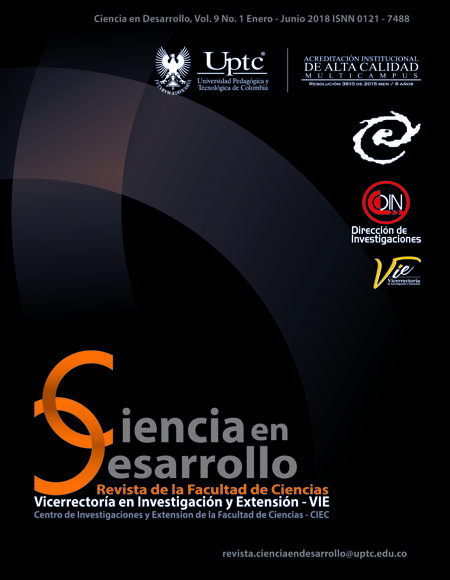EFECTO DEL TIPO DE CATION INTERLAMINAR SOBRE LA CAPACIDAD DE PILARIZACIÓN DE LA MICA SINTÉTICA Na-2-Mica Y LA FORMACIÓN in – situ DE NANOCLUSTERS DE MnS

Resumen
En este trabajo se sintetizó la Na-2-mica por el método sol – gel y se estudió el efecto del intercambio catiónico con litio y hexadecilamonio, previo al proceso de pilarización con el policatión de Keggin de Al, el estudio se realizó variando la densidad de pilares (10,20 y 30 meq. Al3+/g. de mica). El intercambio previo con cationes de hexadecilamonio garantizó la expansión de la interlámina; sin embargo el estudio reveló que después del tratamiento térmico en el proceso de pilarización, la interlámina no se mantiene expandida como lo hacen típicamente los minerales de arcilla pilareados, debido a la elevada carga laminar y a los sitios fuertemente ácidos de la mica. La mayoría de los materiales obtenidos formaron partículas de alúmina (Al2O3) en la interlámina. Adicionalmente se estudió la formación de nanoclusters de MnS incorporados en los materiales resultantes de la pilarización, cuya incorporación se vio restringida respecto al contenido de Al, posiblemente porque la fase alúmina interlaminar impidió el crecimiento de los nanoclusters, por lo que se depositaron sobre la superficie del sólido. Todos los materiales se caracterizaron principalmente por DRX, análisis elemental, estimación de la capacidad de intercambio catiónico CIC y porcentaje de carga compensada - % CC.
Palabras clave
Keggin, mica sintética pilarizada, Na-2-mica, nanoclusters de MnS
Biografía del autor/a
Lisette Ruiz Bravo
Química, Universidad de Nariño
Estudiante de Maestría, Universidad Pedagógica y Tecnológica de Colombia
Luis Alejandro Galeano
Profesor Departamento de Química, Universidad de Nariño
Mery Carolina Pazos Zarama
Profesora Escuela de Química, Universidad Pedagógica y Tecnológica de Colombia
Citas
- ALBA, M., CASTRO, M., NARANJO, M., PAVON, E., (2006). Hydrothermal reactivity of Na-n-micas (n=2, 3, 4). Chemistry of Materials,18(1), 2867-2872. DOI: https://doi.org/10.1021/cm0514802
- CARRADO, K., DECARREAU, A., PETIT, S., BERGAYA, F., LAGALY, G., (2006). Synthetic clay minerals and purification of natural clays. En Developments in Clay Science. Handbook of Clay Science DOI: https://doi.org/10.1016/S1572-4352(05)01004-4
- KOMARNENI, S., RAVELLA, R., PARK, M., (2005). Swelling mica-type clays: synthesis by NaCl melt method, NMR characterization and cation exchange selectivity. Journal of Materials Chemistry, 15(1), 4241–4245. DOI: https://doi.org/10.1039/b509682k
- PAULUS, W., KOMARNENI, S., ROY R., (1992). Bulk synthesis and selective exchange of strontium ions in Na4Mg6Al4Si4O20F4 -mica. Nature, 357(1), 571–573. DOI: https://doi.org/10.1038/357571a0
- YAMAGUCHI, T., KITAJIMA, K., SAKAI, E., DAIMON, M., (2003). Properties of ZrO2-Pillared Fluorine Micas Synthesized Using Poly (vinil alcohol) as a Template Agent. Journal of the Ceramic Society of Japan, 111(1), 567-571. DOI: https://doi.org/10.2109/jcersj.111.567
- SHIMIZU, K., NAKAMURO, Y., YAMANAKA, R., HATAMACHI, T., KODAMA, T., (2006). Pillaring of high charge density synthetic micas (Na-4-mica and Na-3-mica) by intercalation of oxides nanoparticles. Microporus and Mesoporus Materials, 95(1), 135–140. DOI: https://doi.org/10.1016/j.micromeso.2006.05.015
- PRAUS, P., MATYS, J., KOZÁK, O., (2012). Critical evaluation of montmorillonite catalytic activity by means of photodecomposition of phenol. Journal of the Brazilian Chemical Society, 23(1), 1900–1906.
- SHIBATA J, SHIMIZU K, TAKADA Y, SHICHI A, YOSHIDA H, SATOKAWA S., (2004). Structure of active Ag clusters in Ag zeolites for SCR of NO by propane in the presence of hydrogen. Journal of Catalysis, 227(2), 367–74. DOI: https://doi.org/10.1016/j.jcat.2004.08.007
- NOVAK, T., (2008). Manganese-modified porous silicates. National institute of chemistry. 19(1), 1000.
- HOUSECROFF C., SHARPE A., (2006). Química Inorgánica, 1(1). Pearson Prentice Hall.
- RUIZ. L.,(2015). Estudio del Crecimiento in – situ de nanoclusters de Mn intercalados en una mica sintética de alta carga (Na-2-mica). En Trabajo de Grado. Universidad de Nariño.
- GALEANO, L., (2011). Peroxidación catalítica de contaminantes orgánicos en medio acuoso utilizando una bentonita modificada con Al y Fe, Cu o Mn. En Tesis de Doctorado en Ciencias Químicas, Universidad de Salamanca.
- PAVÓN, E., CASTRO, M., NARANJO, M., ORTA, M., PAZOS, C., ALBA, M., (2013). Hydration properties of synthetic high-charge micas saturated with different cations: An experimental approach. American Mineralogist, 98(1), 394–400. DOI: https://doi.org/10.2138/am.2013.4217
- ALBA, M., CASTRO, M., ORTA, M., PAVÓN, E., PAZOS, C., VALENCIA J., (2011). Formation of Organo- HighlyCharged Mica. Langmuir, 27(1), 9711-9718. DOI: https://doi.org/10.1021/la200942u
- IACOMI, F., VASILESCU, M., SIMON, S., (2006). Studies of MnS cluster formation in laumontite zeolite. Surface Science, 600(1), 4323–4327. DOI: https://doi.org/10.1016/j.susc.2006.02.075
- Ingeominas (1999). Manual de Métodos Analíticos: Subdirección de ensayos y servicios tecnológicos, laboratorio de Geoquímica. Bogotá, (1999).
- GÓMEZ, S.P., (2007). Estudio de la influencia de la carga interlaminar de esmectitas, sobre las propiedades fisicoquímicas de arcillas pilarizadas con el sistema Al/Fe. En Trabajo de Grado en Química, Universidad de Nariño.
- PERDIGÓN, A., DEFENG, L., PESQUERA, C., GONZÁLES, F., ORTIZ, B., AGUADO, F., BLANCO, C., (2013). Synthesis of porous clay heterostructures from high charge mica – type aluminosilicates. Journal of Materials Chemistry A, 1(1), 1213 – 1219. DOI: https://doi.org/10.1039/C2TA00543C
- PINNAVAIA, T. J., TZOU, M. S., LANDAU, S. D., RAYTHATHA, R. H., (1984). On the pillaring and delamination of smectite clay catalysts by polyoxo cations of aluminum. Journal of Molecular Catalysis, 27(1), 195–212. DOI: https://doi.org/10.1016/0304-5102(84)85080-4
- VAUGHAN D.E.W., LUSSIER R.J., (1980). Preparation of molecular sieves based on pillared interlayered clays. Proceedings of the 5th International Conference on Zeolites, Naples, Rees L.V.C. Heyden, London.
- FIGUERAS, F., (1988). Pillared clays and catalysis. Catalysis Reviews: Science and Engineering, 30, 471. DOI: https://doi.org/10.1080/01614948808080811
- KODAMA, T., KOMARNENI, S., (1999). Na-4-mica: Cd2+, Ni2+, Co2+, Mn2+ and Zn2+ ion Exchange. Journal of Materials Chemistry, 9(1), 533–539. DOI: https://doi.org/10.1039/a806758i
- STEUDEL A., BATENBURG L.F., FISCHER H.R., WEIDLER P.G., EMERICH K., (2009). Alteration of non-swelling clay minerals and magadiite by acid activation. Applied Clay Science, 44(1), 95–104 DOI: https://doi.org/10.1016/j.clay.2009.02.001
- TORANZO R., VICENTE M.A., BAÑARES - MUÑOZ M.A, GANDIA L.M., GIL A., 1998). Pillaring of saponite with zirconium oligomers. Microporous and Mesoporous Materials, 24(1), 173–188. DOI: https://doi.org/10.1016/S1387-1811(98)00158-9
